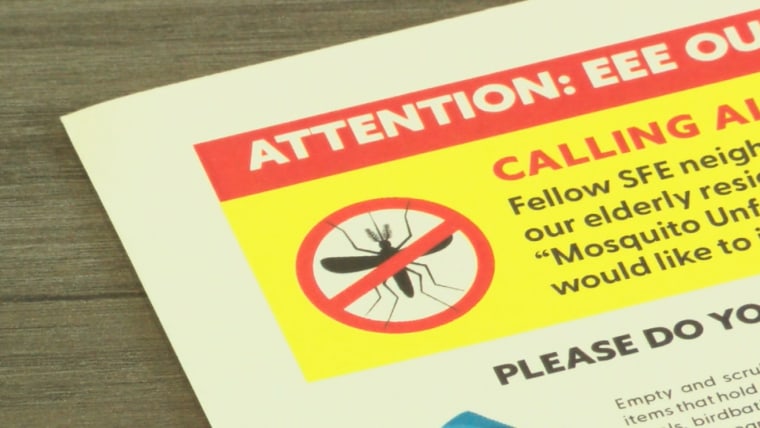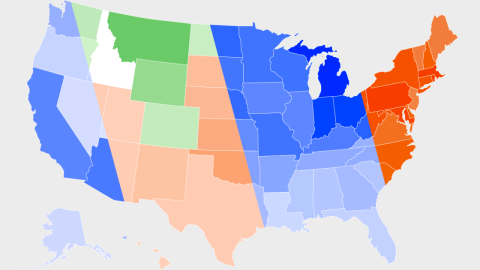As the end of summer approaches, cases of rare insect-borne diseases are cropping up weekly across the country, including eastern equine encephalitis, dengue fever and West Nile virus — all spread by mosquitoes — and the tick-borne Powassan virus.
This week, Alabama reported two cases of eastern equine encephalitis, or EEE, including one death. The rare disease has a 30% fatality rate, and many survivors have lasting neurological issues. In Connecticut, meanwhile, four residents tested positive for Powassan virus, the first infections in the state this year.
The U.S. also recorded its first cases of locally transmitted malaria in two decades this summer: seven in Florida and one each in Maryland and Texas.
Aside from the malaria cases, one-off reports of these rare diseases are thus far not surprising compared to past years, according to four experts interviewed. But they also noted that the situation is difficult to assess until final case counts get tallied later this year, and rising temperatures linked to climate change are likely to make ticks and mosquitoes a threat into the fall this year and in those to come.
A new cluster of Powassan cases
Maria Diuk-Wasser, a vector-borne disease specialist and professor at Columbia University, said it’s unusual to see several Powassan cases at once in the same area, as it recently happened in Connecticut.
Connecticut’s cluster “seems like an outlier of a lot of cases at once,” she said, “but in general, all of these pathogens have been increasing, including Powassan, even though it’s very hard to say exactly when you have such small numbers.”
Prior to the Connecticut cases, a Rhode Island resident died of the virus last week and Maine reported a death in May. The U.S. typically sees about 30 cases annually, Diuk-Wasser said. As of Tuesday, the U.S. has recorded 16 this year, according to the Centers for Disease Control and Prevention. Typically found in the Great Lakes region and the Northeast, Powassan virus has a fatality rate of about 10%. Its symptoms include fever, headache, vomiting and fatigue.
Diuk-Wasser’s lab studies ticks in New York City and its surrounding areas, and she said her team this year has found higher levels of black-legged ticks, which can spread the Powassan virus, as well as Lyme disease.
Health authorities monitor EEE and dengue cases
EEE is among the rarest mosquito-borne diseases in the U.S. Last year, there was only one case, according to the CDC, though the annual average has hovered around eight for the last decade. The 2019 season was an exception with 38 cases, including nine deaths.
The two Alabama cases are the only ones confirmed so far this year, though Michigan, Vermont and New York each reported in the past week that mosquitoes had tested positive for EEE.
The condition causes inflammation of the brain. Symptoms can be nonexistent or mild for some people, but severe cases can lead to fever, headache, vomiting and later seizures and coma.
Jon Rayner, an associate professor of microbiology and immunology at the University of South Alabama, said one or two cases of EEE in a year is not unexpected for his state. But tick and mosquito season is stretching into the fall and winter, especially in the South, he said, adding that he got a tick bite while hiking in January.
“That’s part of the concern with global warming,” he said. “As you see temperatures remaining elevated in subtropical regions for longer periods of time, the transmission season similarly extends.”
In June, the World Health Organization warned that higher temperatures due to global warming have also led to a global spike in dengue fever. In the U.S., the spread of dengue this summer prompted two Florida counties — Broward and Miami-Dade — to issue mosquito-borne illness alerts after both reported locally acquired cases. In total, Florida has tallied 147 cases, and New York has reported the next highest total at 28.
About 1 in 4 people infected with dengue get sick, with symptoms including fever, vomiting, rash and muscle pain, according to the CDC. Most people recover within a week, but about 1 in 20 develop severe dengue, which can become life-threatening within just a few hours after an individual’s fever begins to drop.
The U.S. has logged 642 cases of dengue this year, according to the CDC. That’s far below last year’s total of more than 1,200, but experts said the disease typically peaks in late summer, especially August.
Thousands of West Nile cases arise each year
West Nile virus remains the leading mosquito-borne disease threat in the U.S. As of Aug. 22, 247 cases had been confirmed this year, with Arizona and Colorado reporting the most, according to the CDC. In the past week,
Last year’s case total exceeded 1,100, while 2021 had the highest number of cases since 2012, with more than 3,000, according to a CDC report released Thursday.
Experts said infections are usually logged later in the season — and West Nile typically peaks in late summer and early fall, unlike most other mosquito-borne diseases.
In just the past week, Connecticut reported its first human case of the year, and officials in Montana and Texas warned of rising case counts.
Most people infected with West Nile do not get sick, but about 1 in 5 develop symptoms including fever, headache, body aches, joint pains and vomiting, according to the CDC. About 1 in 150 develop serious or fatal illness that includes inflammation of the brain or spinal cord.
“It’s really those neuroinvasive and neurodegenerative cases of West Nile, which is about 1% of all infections, that are the real serious human cases where you see hospitalizations or long-term disability or maybe death,” said Graham McKeen, assistant director of public and environmental health at Indiana University. “It usually just takes more time throughout the calendar year for us to pick up on those.”
He added that increased surveillance of tick and mosquito populations is key to combating the spread of these diseases.
“We kind of are anticipating seeing these diseases more and more as we continue to alter the climate, and as vectors come into new areas, and as we decrease funding and vector control,” McKeen said.










Recent Comments